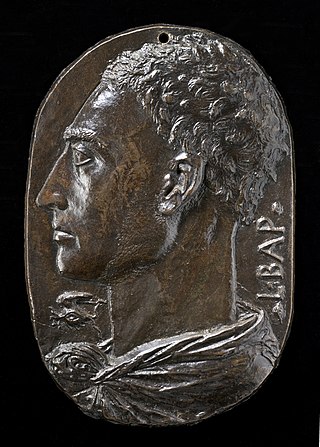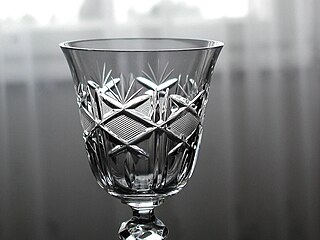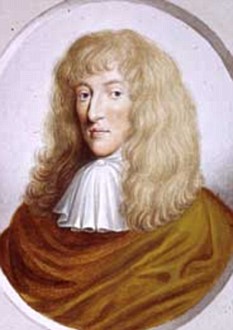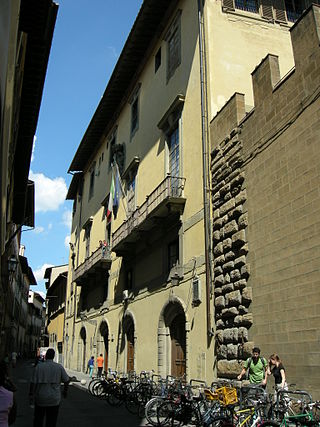Antonio Neri (29 February 1576, Florence – 1614) was a Florentine priest who published the book L’Arte Vetraria or The Art of Glass in 1612. This book was the first general treatise on the systematics of glassmaking. [1]
Antonio Neri (29 February 1576, Florence – 1614) was a Florentine priest who published the book L’Arte Vetraria or The Art of Glass in 1612. This book was the first general treatise on the systematics of glassmaking. [1]
Neri's father was a physician. Neri entered the priesthood in 1601. He then became a member of the household of Alamanno Bertolini where he met the chemist Sir Emmanuel Ximenes, who introduced Neri to the fundamentals of glassmaking. [1] Bertolini was a member of the Medici royal family, and his household in Florence was known as Casino di San Marco. Various glassmakers visited the Bartolini household from time-to-time, giving Neri ample opportunity to learn glassmaking and to eventually develop improved formulations. [2] [3] : 26
In one account, he is known as Antonio Lodovico Neri. [3] : 32

Prior to Neri's time, glassmaking was part of the field of alchemy, and Neri had a background in alchemy. Through his efforts and those of glassmaking contemporaries of Neri, glassmaking began to evolve into a systematic scientific endeavour. [3] : 25–6 An example is that Neri recognized that the red colour in the red glass called "crocus martis" is due to oxidized iron. [3] : 12
Neri travelled extensively in Italy, Antwerp, and Holland. Much of his time in Antwerp was spent with chemist Sir Emmanuel Ximenes from whom Neri learned much of the basic chemistry of glassmaking. Neri also worked in the glasshouses belonging to the Medici family in Florence and in Pisa. These experiences significantly deepened his knowledge of glassmaking and its underlying chemistry. Neri's other endeavours included herbalism and alchemy, in addition to glassmaking. [1] [4]
Much of what is known about Neri's life is based on correspondence between Neri and Ximenes in addition to research conducted by Muranese glass historian Luigi Zecchin during the 1960s. An annotated bibliography of written works by Neri has been published. [5] Much of the correspondence between Neri and Ximenes is preserved at the Biblioteca Nazionale Centrale di Firenze. [3] : 32
Between 1598 and 1600, Neri published his first compilation on glassmaking, Il Tesoro del Mondo, which included some basic information on equipment and raw materials for glassmaking. He was, at the same time, conducting his own experimentation on glassmaking in the household of his Medici family patron in Florence. Following the publication of Il Tesoro del Mondo, Neri began his travels to Antwerp and Pisa, during which time he interacted more frequently with Ximenes. He returned to Florence in 1611, publishing L'Arte Vetraria the following year. [3] : 32

In 1612, Neri published a seven-volume treatise, L' Arte Vetraria, that was a significant step toward systematizing the preparation of glass. The title of the book translates to English as The Art of Glass. The first volume describes the materials, mixing, and melting of the ingredients to produce crystals and colorless glass. Subsequent volumes describe colored glasses, leaded glass, artificial gemstones, enamels, and glass paints. The treatise includes many glass formulations that were devised by Neri by improving on formulations that he became aware of through his work in the Medici court, through his interactions with Ximenez, and likely other sources. [1] [2]
The contents of L'Arte Vetraria volume-by-volume are: [5]
L'Arte Vetraria went through three editions up until 1817. By 1752, it had been translated into Dutch, French, and English. [4]
While Neri's contemporary Galileo Galilei made note of L'Arte Vetraria, more widespread recognition of the treatise came later. In 1662, British physician and scientist Christopher Merret published an English translation of L'Arte Vetraria, which included extensive annotations by Merret. Subsequent translations were usually based on Merret's version of Neri's treatise. By 1900, there were an estimated two dozen translations based on Merret's version or on Neri's original version. The L'Arte Vetraria was a standard reference book among glassmakers up until approximately 1900 and served to enhance the ability of glassmakers to improve upon prior glassmaking processes. [1] [2]

Leon Battista Alberti was an Italian Renaissance humanist author, artist, architect, poet, priest, linguist, philosopher, and cryptographer; he epitomised the nature of those identified now as polymaths. He is considered the founder of Western cryptography, a claim he shares with Johannes Trithemius.

Marsilio Ficino was an Italian scholar and Catholic priest who was one of the most influential humanist philosophers of the early Italian Renaissance. He was an astrologer, a reviver of Neoplatonism in touch with the major academics of his day, and the first translator of Plato's complete extant works into Latin. His Florentine Academy, an attempt to revive Plato's Academy, influenced the direction and tenor of the Italian Renaissance and the development of European philosophy.

Florence Cathedral, formally the Cathedral of Saint Mary of the Flower, is the cathedral of Florence, Italy. It was begun in 1296 in the Gothic style to a design of Arnolfo di Cambio and was structurally completed by 1436, with the dome engineered by Filippo Brunelleschi. The exterior of the basilica is faced with polychrome marble panels in various shades of green and pink, bordered by white, and has an elaborate 19th-century Gothic Revival façade by Emilio De Fabris.

Lead glass, commonly called crystal, is a variety of glass in which lead replaces the calcium content of a typical potash glass. Lead glass contains typically 18–40% lead(II) oxide (PbO), while modern lead crystal, historically also known as flint glass due to the original silica source, contains a minimum of 24% PbO. Lead glass is often desirable for a variety of uses due to its clarity. In marketing terms it is often called crystal glass.

Luigi Antonio Lanzi was an Italian art historian and archaeologist. When he died he was buried in the church of the Santa Croce at Florence by the side of Michelangelo.

Emilio de' Cavalieri, or Emilio dei Cavalieri, was an Italian composer, producer, organist, diplomat, choreographer and dancer at the end of the Renaissance era. His work, along with that of other composers active in Rome, Florence and Venice, was critical in defining the beginning of the musical Baroque era. A member of the Roman School of composers, he was an influential early composer of monody, and wrote what is usually considered to be the first oratorio.

Prince Rupert's drops are toughened glass beads created by dripping molten glass into cold water, which causes it to solidify into a tadpole-shaped droplet with a long, thin tail. These droplets are characterized internally by very high residual stresses, which give rise to counter-intuitive properties, such as the ability to withstand a blow from a hammer or a bullet on the bulbous end without breaking, while exhibiting explosive disintegration if the tail end is even slightly damaged. In nature, similar structures are produced under certain conditions in volcanic lava, and are known as Pele's tears.

Christopher Merret FRS, FRCP, also spelt Merrett, was an English physician and scientist. He was the first to document the deliberate addition of sugar for the production of sparkling wine, and produced the first lists of British birds and butterflies.

Vincenzo Ι Gonzaga was the ruler of the Duchy of Mantua and the Duchy of Montferrat from 1587 to 1612.

Venetian glass is glassware made in Venice, typically on the island of Murano near the city. Traditionally it is made with a soda–lime "metal" and is typically elaborately decorated, with various "hot" glass-forming techniques, as well as gilding, enamel, or engraving. Production has been concentrated on the Venetian island of Murano since the 13th century. Today Murano is known for its art glass, but it has a long history of innovations in glassmaking in addition to its artistic fame—and was Europe's major center for luxury glass from the High Middle Ages to the Italian Renaissance. During the 15th century, Murano glassmakers created cristallo—which was almost transparent and considered the finest glass in the world. Murano glassmakers also developed a white-colored glass that looked like porcelain. They later became Europe's finest makers of mirrors.

Stradanus, Johannes Stradanus, Jan van der Straet or Giovanni Stradano was a Flemish artist active mainly in 16th-century Florence, Italy. He was a wide-ranging talent who worked as an easel and fresco painter, designer of tapestries, draughtsman, designer of prints and pottery decorator. His subject range was varied and included history subjects, mythological scenes, allegories, landscapes, genre scenes, portraits, architectural scenes and animals. After training in his native Flanders, he left his home country and ultimately settled down in Florence, Italy. He became a prominent court artist to the Medici during the second half of the 16th century and worked on the many decorative projects of the court. Stradanus also produced large altarpieces for the most important churches in Florence.

Caspar Barlaeus was a Dutch polymath and Renaissance humanist, a theologian, poet, and historian.

Pierre Francqueville, generally called Pietro Francavilla, was a Franco-Flemish sculptor trained in Florence, who provided sculpture for Italian and French patrons in the elegant Late Mannerist tradition established by Giambologna.

Andreas Schott was an academic, linguist, translator, editor and a Jesuit priest from Antwerp in the Habsburg Netherlands. He was mainly known for his editions of Latin and Greek classical literature.

The Lives of the Most Excellent Painters, Sculptors, and Architects, often simply known as The Lives, is a series of artist biographies written by 16th-century Italian painter and architect Giorgio Vasari, which is considered "perhaps the most famous, and even today the most-read work of the older literature of art", "some of the Italian Renaissance's most influential writing on art", and "the first important book on art history".

George Ravenscroft was an English businessman in the import/export and glass making trades. He is primarily known for his work in developing clear lead crystal glass in England.

The Biblioteca Riccardiana is an Italian public library under the aegis of the Ministry of Culture, located inside the Palazzo Medici Riccardi at 10 Via de’ Ginori in Florence, in the neighborhood comprising the Mercato Centrale and the Basilica di San Lorenzo. Its main feature is preserving books collected by members of the Riccardi family and making them available in the very same rooms that were originally dedicated to that purpose. So, still today the library boasts the magnificent bookshelves, neatly carved and gilded, that create the atmosphere of a late-seventeenth-century patrician library, whose main features have all been kept intact.
J. H. Hobbs, Brockunier and Company was one of the largest and best-known manufacturers of glass in the United States during the 19th century. Its products were distributed worldwide. The company is responsible for one of the greatest innovations in American glassmaking—an improved formula for lime glass that enabled American glass manufacturers to produce high-quality glass at a lower cost. The firm also developed talented glassmakers that started glass factories in Ohio and Indiana.

Cut glass or cut-glass is a technique and a style of decorating glass. For some time the style has often been produced by other techniques such as the use of moulding, but the original technique of cutting glass on an abrasive wheel is still used in luxury products. On glassware vessels, the style typically consists of furrowed faces at angles to each other in complicated patterns, while for lighting fixtures, the style consists of flat or curved facets on small hanging pieces, often all over. Historically, cut glass was shaped using "coldwork" techniques of grinding or drilling, applied as a secondary stage to a piece of glass made by conventional processes such as glassblowing.

19th century glassmaking in the United States started slowly with less than a dozen glass factories operating. Much of the nation's better quality glass was imported, and English glassmakers had a monopoly on major ingredients for high–quality glass such as good–quality sand and red lead. A tariff and the War of 1812 added to the difficulties of making crystal glass in America. After the war, English glassmakers began dumping low priced glassware in the United States, which caused some glass works to go out of business. A protective tariff and the ingenuity of Boston businessman Deming Jarves helped revive the domestic glass industry.
{{cite book}}: |first2= has generic name (help)